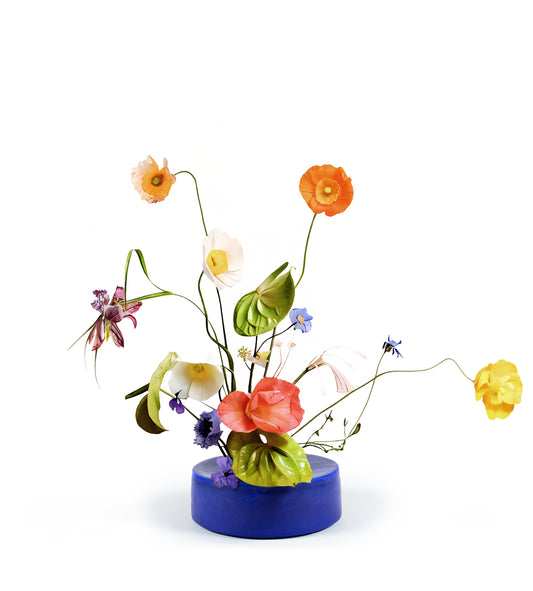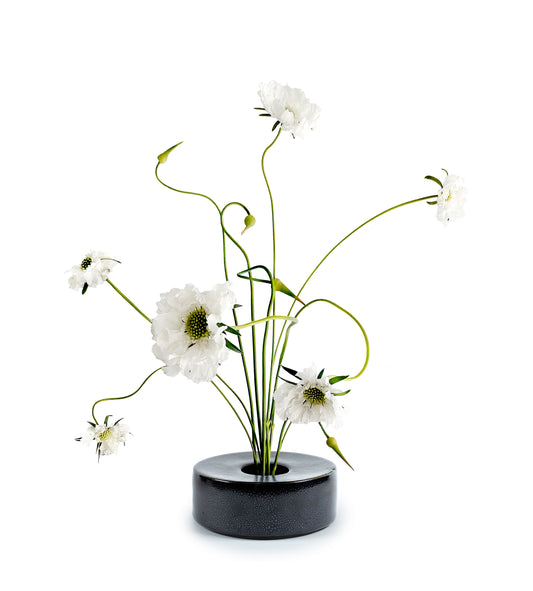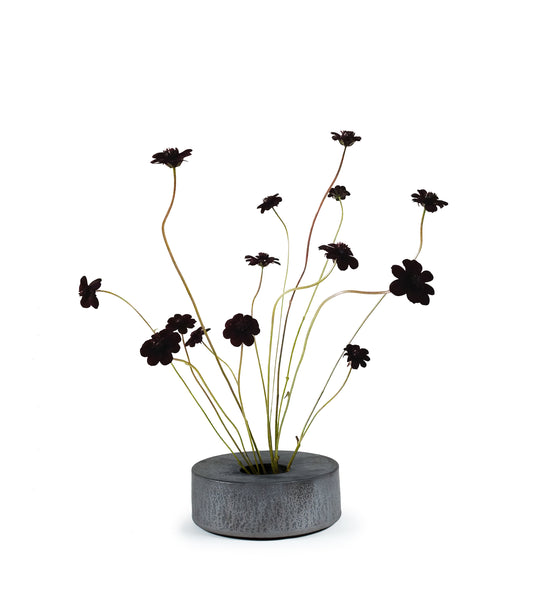Ikebana has always been about balance - between nature and form, stillness and movement. At Dweller Studio, we designed our modern Ikebana vases to bring this centuries-old art into contemporary living spaces.
Unlike traditional open bowls, each Dweller Studio Ikebana vase is an enclosed ceramic disc with a built-in flower frog fixed to the base. This design simplifies the process: just add water, select a few stems, and create a sculptural arrangement that feels both organic and architectural.
Here’s how to use it.
Step 1: Fill the Vase
Begin by adding water through the top opening.
Each ceramic Ikebana vase is watertight and designed to hold just enough for your arrangement - typically until the pins of the built-in frog are fully submerged.
Because the frog is secured inside the vessel, you don’t need to worry about it shifting or floating - a small but significant improvement over traditional vases for Ikebana.
Tip: Use filtered or room-temperature water. Clear water enhances the reflective depth visible through the vase’s opening.
Step 2: Prepare Your Stems
Ikebana emphasizes the natural line of each stem. Choose flowers and branches that contrast in height and texture.
For Dweller’s Japanese Ikebana-inspired vases, fewer stems work best — the narrow opening and fixed frog are meant to highlight negative space.
Suggested pairings:
-
One tall structural branch (like curly willow or tulip magnolia)
-
One or two blooms (anemone, ranunculus, or chrysanthemum)
-
A small filler (fern frond, reed, or dried seed pod)
Trim stems at a diagonal so they absorb water more easily, and remove any leaves below the surface line to keep the water clear.
Step 3: Insert the Stems into the Built-In Flower Frog
With the water filled, gently press each stem into the fixed pins.
Because the frog is positioned at the center of the vessel, the stems naturally fan out from the middle - creating a sculptural form that looks balanced from every angle.
Experiment with asymmetry: let one stem lean outward, another reach vertically, and a third rest closer to the vase opening. The Dweller Studio vase design allows you to play with direction while maintaining full stability.
Think of the built-in frog as your guide - it helps you focus less on setup and more on composition.
Step 4: Refine the Form
Once your stems are placed, take a step back.
A good Ikebana flower vase should invite quiet observation - the balance between form and emptiness, water and material.
In Dweller Studio’s enclosed design, light and shadow interact with the round ceramic body, emphasizing the stillness at its center. Small adjustments to angle or height can dramatically change the arrangement’s energy.
Step 5: Maintain and Refresh
Because the vessel is enclosed, your water will stay fresh longer than in open-bowl designs. Still, for best care:
- Replace the water every 2–3 days.
-
Trim stems slightly when refreshing to extend their life.
-
Avoid direct sunlight - ceramic holds temperature well, keeping the water cool.
To clean, empty the vase through the opening, rinse with warm water, and let it air dry fully before storing.
Why Dweller Studio’s Ikebana Vase Is Different
Traditional Japanese Ikebana vases often require a separate kenzan or shallow basin.
Dweller Studio’s design reimagines that tradition — creating a ceramic Ikebana vase that feels modern yet deeply tied to the meditative roots of the craft.
Each piece is hand-finished with reactive glazes that echo geological movement inside the kiln - no two are identical. The built-in flower frog, hidden within the smooth ceramic form, simplifies the ritual of arranging, allowing anyone to experience Ikebana as a daily practice.
It’s a modern Ikebana - one that belongs as much on a sculptural shelf as it does in a quiet corner filled with morning light.





